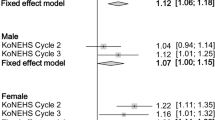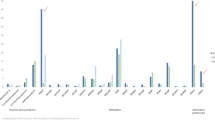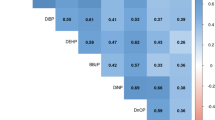Abstract
Bisphenol A (BPA) is one of the highest production and consumption volume chemicals in the world. Although exposure of children to BPA has been studied in Western countries, little is known about its level in China. In this study, total BPA was measured in the morning urine samples of 666 school children aged 9–12 years from three regions in eastern China in 2012. A rapid and sensitive ultraperformance liquid chromatography (UPLC) tandem mass spectrometry (MS/MS) method was used for the measurement and urinary concentrations of BPA were presented as unadjusted (ng/ml), creatinine-adjusted (μg/g creatinine) and specific gravity (SG)-adjusted (ng/ml) forms. BPA was detected in 98.9% of urine samples with their unadjusted concentrations ranging from 0.1 to 326.0 ng/ml (LOD=0.06 ng/ml), indicating that the exposure of BPA was common for school children living in eastern China. The geometric mean and median of BPA was 1.11 ng/ml (creatinine-adjusted: 2.32 μg/g creatinine; SG-adjusted: 1.17 ng/ml) and 1.00 ng/ml (creatinine-adjusted: 2.22 μg/g creatinine; SG-adjusted: 1.07 ng/ml), respectively. The highest urinary BPA level was found in the age group of 12 years with GM concentration of 1.55 ng/ml, and it decreased with decreasing age (11 years: 1.18 ng/ml; 10 years: 1.05 ng/ml; and 9 years: 0.99 ng/ml), but there was a lack of consistency for age associated with BPA levels in three study areas. The estimated daily intake of BPA (0.023 μg/kg bw/day) was much lower than the tolerable daily and reference dose of 50 μg/kg bw/day recommended by either the European Food Safety Authority or the US Environment Protection Agency. There was no significant difference in urinary BPA concentrations between children who were overweight or obese and those with normal weight (P=0.26), whereas BPA daily intake was unexpectedly higher among normal-weight children (P=0.003). Compared with creatinine correction, the correction method of specific gravity is preferred to evaluate BPA exposure for children.
This is a preview of subscription content, access via your institution
Access options
Subscribe to this journal
Receive 6 print issues and online access
$259.00 per year
only $43.17 per issue
Buy this article
- Purchase on Springer Link
- Instant access to full article PDF
Prices may be subject to local taxes which are calculated during checkout


Similar content being viewed by others
References
Vandenberg LN, Chahoud I, Heindel JJ, Padmanabhan V, Paumgartten FJ, Schoenfelder G . Urinary, circulating, and tissue biomonitoring studies indicate widespread exposure to bisphenol A. Environ Health Perspect 2010; 118: 1055–1070.
Huang YQ, Wong CKC, Zheng JS, Bouwman H, Barra R, Wahlstrom B et al. Bisphenol A (BPA) in China: a review of sources, environmental levels, and potential human health impacts. Environ Int 2012; 42: 91–99.
Jiao FR, Sun XJ, Pang ZT . Production and market analysis of Bisphenol A. Chem Ind 2008; 26: 21–33.
Welshons WV, Nagel SC, vom Saal FS . Large effects from small exposures. III. Endocrine mechanisms mediating effects of bisphenol A at levels of human exposure. Endocrinology 2006; 147: S56–S69.
Lang IA, Galloway TS, Scarlett A, Henley WE, Depledge M, Wallace DM . Association of urinary bisphenol A concentration with medical disorders and laboratory abnormalities in adults. JAMA 2008; 300: 1303–1310.
Trasande L, Attina TM, Blustein J . Association between urinary bisphenol A concentration and obesity prevalence in children and adolescents. JAMA 2012; 308: 1113–1121.
Wang HX, Zhou Y, Tang CX, Wu JG, Chen Y, Jiang QW . Association between bisphenol A exposure and body mass index in Chinese school children: a cross-sectional study. Environ Health 2012; 11: 79.
Geens T, Aerts D, Berthot C, Bourguignon JP, Goeyens L, Lecomte P et al. A review of dietary and non-dietary exposure to bisphenol-A. Food Chem Toxicol 2012; 50: 3725–3740.
Kang JH, Kondo F, Katayama Y . Human exposure to bisphenol A. Toxicology 2006; 226: 79–89.
Vandenberg LN, Hauser R, Marcus M, Olea N, Welshons WV . Human exposure to bisphenol A (BPA). Reprod Toxicol 2007; 24: 139–177.
Calafat AM, Ye X, Wong LY, Reidy JA, Needham LL . Exposure of the U.S. population to bisphenol A and 4-tertiary-octylphenol: 2003–2004. Environ Health Perspect 2008; 116: 39–44.
Kim YH, Kim CS, Park S, Han SY, Pyo MY, Yang M . Gender differences in the levels of bisphenol A metabolites in urine. Biochem Biophys Res Commun 2003; 312: 441–448.
Becker K, Göen T, Seiwert M, Conrad A, Pick-Fuß H, Müller J et al. GerES IV: phthalate metabolites and bisphenol A in urine of German children. Int J Hyg Environ Health 2009; 212: 685–692.
Arakawa C, Fujimaki K, Yoshinaga J, Imai H, Serizawa S, Shiraishi H . Daily urinary excretion of bisphenol A. Environ Health Prev Med 2004; 9: 22–26.
Bushnik T, Haines D, Levallois P, Levesque J . Lead and bisphenol A concentrations in the Canadian populations. Stat Can Health Rep 2010; 21: 7–18.
Lakind JS, Naiman DQ . Daily intake of bisphenol A and potential sources of exposure: 2005–2006 National Health and Nutrition Examination Survey. J Expo Sci Environ Epidemiol 2011; 21: 272–279.
Li X, Ying GG, Zhao JL, Chen ZF, Lai HJ, Su HC . 4-Nonylphenol, bisphenol-A and triclosan levels in human urine of children and students in China, and the effects of drinking these bottled materials on the levels. Environ Int 2013; 52: 81–86.
He Y, Miao M, Herrinton LJ, Wu C, Yuan W, Zhou Z et al. Bisphenol A levels in blood and urine in a Chinese population and the personal factors affecting the levels. Environ Res 2009; 109: 629–633.
Ji CY . Report on childhood obesity in China (1) —Body mass index reference for screening overweight and obesity in Chinese school-age children. Biomed Environ Sci 2005; 18: 390–400.
Wang HX, Wang B, Zhou Y, Jiang QW . Rapid and sensitive analysis of phthalate metabolites, bisphenol A, and endogenous steroid hormones in human urine by mixed-mode solid-phase extraction, dansylation, and ultra-performance liquid chromatography coupled with triple quadrupole mass spectrometry. Anal Bioanal Chem 2013, 1–7.
CDC General Information about the NHANES 2003–2004 Laboratory Methodology and Public Data Files. Available at http://www.cdc.gov/nchs/data/nhanes/nhanes_03_04/lab_c_generaldoc.pdf 2006, accessed on June 2013.
Hornung RW, Reed LD . Estimation of average concentration in the presence of nondetectable values. Appl Occup Environ Hyg 1990; 5: 46–51.
Miller RC, Brindle E, Holman DJ, Shofer J, Klein NA, Soules MR et al. Comparison of specific gravity and creatinine for normalizing urinary reproductive hormone concentrations. Clin Chem 2004; 50: 924–932.
Lakind JS, Naiman DQ . Bisphenol A (BPA) daily intakes in the United States: estimates from the 2003–2004 NHANES urinary BPA data. J Expo Sci Environ Epidemiol 2008; 18: 608–615.
Valentin J . Basic anatomical and physiological data for use in radiological protection: reference values: ICRP Publication 89. Ann ICRP 2002; 32: 5–265.
ICRP. ICRP Publication 89. Basic Anatomical and Physiological Data for Use in Radiological Protection: Reference Values. Elsevier. 2003 pp 280.
Barbanel CS, Winkelman JW, Fischer GA, King AJ . Confirmation of the Department of Transportation criteria for a substituted urine specimen. J Environ Med 2002; 44: 407–416.
WHO. Biological Monitoring of Chemical Exposure in the Workplace Vol 1. World Health Organization: Geneva. 1996.
Yamano Y, Miyakawa S, Iizumi K, Itoh H, Iwasaki M, Tsugane S et al. Long-term study of urinary bisphenol A in elementary school children. Environ Health Prev Med 2008; 13: 332–337.
Nahar MS, Soliman AS, Colacino JA, Calafat AM, Battige K, Hablas A et al. Urinary bisphenol A concentrations in girls from rural and urban Egypt: a pilot study. Environ Health 2012; 11: 20.
WHO 2010 Joint FAO/WHO Expert Meeting to Review Toxicological and Health Aspects of Bisphenol A. Summary report. 2010. Available from http://www.who.int/foodsafety/chem/chemicals/BPA_Summary2010.pdf?ua=1 accessed on June 2013.
Calafat AM, Kuklenyik Z, Reidy JA, Caudill SP, Ekong J, Needham LL . Urinary concentrations of bisphenol A and 4-nonylphenol in a human reference population. Environ Health Perspect 2005; 113: 391–395.
Hong YC, Park EY, Park MS, Ko JA, Oh SY, Kim H et al. Community level exposure to chemicals and oxidative stress in adult population. Toxicol Lett 2009; 184: 139–144.
Liu Z, Wolff MS, Moline J . Analysis of environmental biomarkers in urine using an electrochemical detector. J Chromatogr B 2005; 819: 155–159.
Wolff MS, Engel SM, Berkowitz GS, Ye X, Silva MJ, Zhu C et al. Prenatal phenol and phthalate exposures and birth outcomes. Environ Health Perspect 2008; 116: 1092–1097.
Yang M, Kim SY, Chang SS, Lee IS, Kawamoto T . Urinary concentrations of bisphenol A in relation to biomarkers of sensitivity and effect and endocrine-related health effects. Environ Mol Mutagen 2006; 47: 571–578.
Ye X, Kuklenyik Z, Needham LL, Calafat AM . Automated on-line column-switching HPLC-MS/MS method with peak focusing for the determination of nine environmental phenols in urine. Anal Chem 2005; 77: 5407–5413.
Ye X, Pierik FH, Hauser R, Duty S, Angerer J, Park MM et al. Urinary metabolite concentrations of organophosphorous pesticides, bisphenol A, and phthalates among pregnant women in Rotterdam, the Netherlands: the Generation R study. Environ Res 2008; 108: 260–267.
Carrieri M, Trevisan A, Battista-Bartolucci G . Adjustment to concentration-dilution of spot urine samples: correlation between specific gravity and creatinine. Int Arch Occup Environ Health 2000; 74: 1432–1446.
O’Rourke MK, Lizardi PS, Rogan SP, Freeman NC, Aguirre A, Saint CG . Pesticide exposure and creatinine variation among young children. J Expo Anal Environ Epidemiol 2000; 10: 672–681.
Barr DB, Wilder LC, Caudill SP, Gonzalez AJ, Needham LL, Pirkle JL . Urinary creatinine concentrations in the U.S. Population: implications for urinary biologic monitoring measurements. Environ Health Perspect 2005; 113: 192–200.
Needham LL, Calafat AM, Barr DB . Uses and issues of biomonitoring. Int J Hyg Environ Health 2007; 210: 229–238.
Zhang Z, Alomirah H, Cho H, Li Y, Liao C, Tu BM et al. Urinary Bisphenol a concentrations and their implications for human exposure in several Asian countries. Environ Sci Technol 2011; 45: 7044–7050.
European Commission (EC) Opinion of the scientific committee on food on bisphenol A http://ec.europa.eu/food/fs/sc/scf/out128_en.pdf accessed on June 2013 2002.
EFSA (European Food Safety Authority). Opinion of the Scientific Panel on Food Additives, Flavourings, Processing Aids and Materials in Contact with Food (AFC) Related to 2,2-bis(4-hydroxyphenyl)propane. Available at http://www.efsa.europa.eu/en/efsajournal/doc/428.pdf accessed on June 2013 2007.
EPA (United States Environmental Protection Agency). Bisphenol A, Integrated Risk Information System. Available at http://www.epa.gov/iris/subst/0356.htm accessed on June 2013 2009.
Richter C, Birnbaum LS, Farabollini F, Newbold RR, Rubin BS, Talsness CE . In vivo effects of bisphenol A in laboratory rodent studies. Reprod Toxicol 2007; 24: 199–224.
Vandenberg LN, Maffini MV, Sonnenschein C, Rubin BS, Soto AM . Bisphenol-A and the great divide: a review of controversies in the field of endocrine disruption. Endocrine Rev 2009; 30: 75–95.
Wilson NK, Chuang JC, Morgan MK, Lordo RA, Sheldon LS . An observational study of potential exposures of preschool children to pentachlorophenol, bisphenol-A, and nonylphenol at home and daycare. Environ Res 2007; 103: 9–20.
von Goetz N, Wormuth M, Scheringer M, Hüngerbuhler K . Bisphenol-A: how the most relevant exposure sources contribute to total consumer exposure. Risk Anal 2010; 30: 473–487.
Morgan MK, Jones PA, Calafat AM, Ye XY, Croghan CW, Chuang JC et al. Assessing the Quantitative Relationships between Preschool Children’s Exposures to Bisphenol A by Route and Urinary Biomonitoring. Environ Sci Technol 2011; 45: 5309–5316.
CDC Fourth National Report on Human Exposure and Environmental Chemicals, updated tables, March 2013, pp 1–324 http://www.cdc.gov/exposurereport/pdf/FourthReport_UpdatedTables_Mar2013.pdf, accessed on June 2013 2013.
Frederiksen H, Aksglaede L, Sorensen K, Nielsen O, Main KM, Skakkebaek NE et al. Bisphenol A and other phenols in urine from Danish children and adolescents analyzed by isotope diluted TurboFlow-LC-MS/MS. Int J Hyg Environ Health 2013, 1–11.
Acknowledgements
This study was supported by the Natural Science Foundation of China (No. 81373089), 985 Innovation Platform Project for Superiority Subject of Ministry of Education of China (No. EZF201001), grants of the National Health Research Program from the State Ministry of Health of China (No. 201202012) and New Teacher Fund for Doctor Station, the Ministry of Education of China (No. 20120071120051).
Author information
Authors and Affiliations
Corresponding author
Ethics declarations
Competing interests
The authors declare no conflict of interest.
Additional information
Supplementary Information accompanies the paper on the Journal of Exposure Science and Environmental Epidemiology website
Supplementary information
Rights and permissions
About this article
Cite this article
Wang, B., Wang, H., Zhou, W. et al. Exposure to bisphenol A among school children in eastern China: A multicenter cross-sectional study. J Expo Sci Environ Epidemiol 24, 657–664 (2014). https://doi.org/10.1038/jes.2014.36
Received:
Revised:
Accepted:
Published:
Issue Date:
DOI: https://doi.org/10.1038/jes.2014.36
Keywords
This article is cited by
-
Environmental exposure to urinary Bisphenol-A in North Indian children aged between 6 and 16 years and its association with body mass index
Environmental Science and Pollution Research (2021)
-
Abnormal differentiation of regulatory T cells and Th17 cells induced by perinatal bisphenol A exposure in female offspring mice
Molecular & Cellular Toxicology (2020)
-
Bisphenol A and pubertal height growth in school-aged children
Journal of Exposure Science & Environmental Epidemiology (2019)
-
Possible Obesogenic Effects of Bisphenols Accumulation in the Human Brain
Scientific Reports (2018)
-
Trends in Exposure to Chemicals in Personal Care and Consumer Products
Current Environmental Health Reports (2015)



